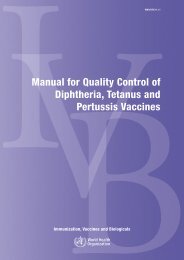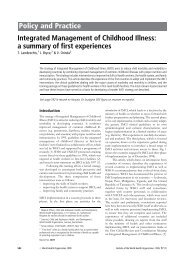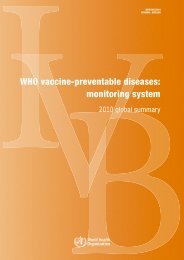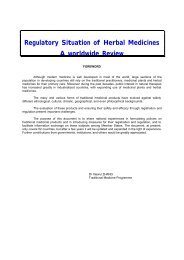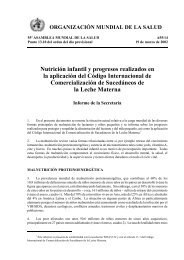IPDE - Extranet Systems - World Health Organization
IPDE - Extranet Systems - World Health Organization
IPDE - Extranet Systems - World Health Organization
You also want an ePaper? Increase the reach of your titles
YUMPU automatically turns print PDFs into web optimized ePapers that Google loves.
29 Epidemiology of DSM-Ill PDs<br />
were reported with structured interviews, 1.7% with the SIPDL2 and<br />
2.2% with the SCID.'OAnother study" carried out at the ECA Baltimore<br />
site, ascertained the prevalence of compulsive PD in the community. and<br />
found a prevalence of 1.7%. Males had a rate about five times higher<br />
than females. The disorder was also more frequent among white, highly<br />
educated, married, and employed subjects, and it was associated with<br />
anxiety disorders. However, the study derived the diagnosis from an<br />
interview originally not intended to diagnose PDs. This could mean that<br />
they identified adaptive obsessive-compulsive traits rather than a PD.<br />
Using the PDQ, Zimmerman and C~ryell'~ found a low rate (0.4%),<br />
while Reich et al,15 in their study, which included only 235 subjects,<br />
found no cases. The rate was higher with an interview, suggesting that<br />
passive-aggressive persons may under-report on self-administered questionnaires.<br />
Epidemiological studies carried out in psychlatric settings<br />
Table 3 lists the main prevalence studies of PD carried out in in-patient<br />
and out-patient psychiatric samples.<br />
To summarize, although the prevalence of PD among psychiahic outpatients<br />
and in-patients can be high, both in patients with only a PD and in<br />
those with an Axis I disorder (especially affective disorders), no final wnclusion<br />
can be reached because the available sNdieS reported very different<br />
prevalence rates. The differences are probably due to differences in sampling,<br />
diagnostic criteria, assessment methods, availability of mental health<br />
services, prevalence of Axis I disorders, and sociocultural factors. Even<br />
when authors use ICD or DSM criteria, they may have done so in different<br />
ways. There are, however, some consistencies acmss studies. The most<br />
prevalent PD seems to be hoderline, both in in-patient and out-patient settings.<br />
The next most common FDs tend to be schiwtypal and histrionic.<br />
These three disorders are also characterized by the lowest social functioning.<br />
They are especially common in in-patient settings, as theirsymptomatology<br />
often results in hospitaliition due to suicidal hehavim, substance<br />
abuse, and cognitive-perceptual abnormalities. In out-patient settings,<br />
dependent and passive-aggressive PDs are also common.<br />
In a study carried out among 2344 patients attending a public psychiatric<br />
facility and having a DSM-111 diagnosis of PD, cluster B patients




